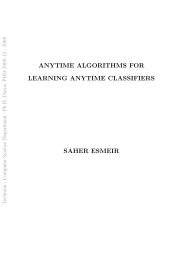Computing Extremal Quasiconformal Maps - Technion
Computing Extremal Quasiconformal Maps - Technion
Computing Extremal Quasiconformal Maps - Technion
You also want an ePaper? Increase the reach of your titles
YUMPU automatically turns print PDFs into web optimized ePapers that Google loves.
O. Weber & A. Myles & D. Zorin / <strong>Computing</strong> <strong>Extremal</strong> <strong>Quasiconformal</strong> <strong>Maps</strong><br />
3. Background<br />
In our exposition we primarily focus on maps from plane<br />
to plane. Due to conformal invariance, all concepts can be<br />
easily generalized to surfaces of genus zero by mapping the<br />
surface conformally to the plane. However, as we briefly explain<br />
in Section 6 all concepts and the algorithm can be extended<br />
to surfaces of arbitrary genus.<br />
We will use complex coordinates in the plane, z = x + iy.<br />
For an arbitrary (not necessarily holomorphic) differentiable<br />
function f (z), the complex derivatives are fz = 1 2 ( fx − i fy)<br />
and f¯z = 1 2 ( fx + i fy). We assume that for all maps these<br />
derivatives are defined almost everywhere, and are squareintegrable.<br />
For each complex number z we define a ma-<br />
Re(z) −Im(z)<br />
trix A(z) =<br />
and a vector v(w) =<br />
Im(z) Re(z)<br />
(Re(w),Im(w)) ⊤ , so that zw corresponds to A(z)v(w).<br />
Dilatation and quasiconformal maps. The little dilatation<br />
of a differentiable map f at z is defined as<br />
<br />
<br />
k(z) = <br />
f¯z<br />
<br />
<br />
<br />
fz<br />
<br />
(1)<br />
It is related to the ratio K of singular values of the Jacobian<br />
of f (large dilatation) by K = 1+k<br />
1−k . A map f : D → D′ is<br />
quasiconformal if k(z) ≤ k for some k almost everywhere in<br />
D. In this case, k( f ) = supk(z) is the maximal dilatation of<br />
the map. The dilatation k has the following important properties:<br />
• 0 ≤ k < 1 for orientation-preserving maps, and 1 ≤ k ≤ ∞<br />
for orientation reversing maps.<br />
• for a conformal map k = 0 and a conformal map composed<br />
with reflection k = ∞.<br />
An advantage of considering k instead of K is that k varies<br />
continuously as the sign of the determinant of the Jacobian<br />
of f changes on folds, while K has a singularity (cf. comparison<br />
of functionals in Section (2)).<br />
For a quasiconformal map with fz = 0 almost everywhere,<br />
µ = f¯z/ fz is called the complex Beltrami coefficient, (Figure<br />
1) and the equation<br />
is the Beltrami equation.<br />
1–k<br />
f¯z = µ fz<br />
θ<br />
1+k<br />
θ = 1<br />
arg μ<br />
2<br />
Figure 1: Geometric meaning of the complex Beltrami coefficient<br />
µ = ke 2iθ .<br />
If g and h are conformal, then h ◦ f ◦ g is quasiconformal<br />
with the same dilatation k as f . The simplest map with dilatation<br />
k is an affine stretch Ak along the two coordinate<br />
c○ 2012 The Author(s)<br />
c○ 2012 The Eurographics Association and Blackwell Publishing Ltd.<br />
(2)<br />
axes by 1 + k and 1 − k respectively; this yields a family of<br />
quasiconformal maps with constant dilatation k(z) = k, of<br />
the form<br />
f = h ◦ Ak ◦ g. (3)<br />
This simple example of quasiconformal maps plays an important<br />
role in the theory of extremal quasiconformal maps.<br />
<strong>Extremal</strong> quasiconformal maps. Suppose a quasiconformal<br />
map h : D → D ′ maps a (possibly multiply connected)<br />
domain D to D ′ . Let B be a subset of the boundary of D, and<br />
consider the set QB of all quasiconformal maps f that agree<br />
with h on B and are homotopic to h (Figure 2). In the set QB<br />
there is a map f ext , with k( f ext ) ≤ k( f ) for any f . The map<br />
f ext is called the extremal quasiconformal map.<br />
A<br />
B<br />
Figure 2: Examples of nonhomotopic maps with the same<br />
boundary data on ring domain; the left plot represents identity;<br />
note that the path AB connecting two boundary points<br />
on the right, cannot be continuously deformed to the spiral<br />
path AB on the left, while keeping the boundary fixed. An<br />
extremal quasiconformal map is unique for each homotopy<br />
class under assumptions of Proposition 2.<br />
2π<br />
π<br />
0<br />
A<br />
B<br />
zero derivative<br />
Figure 3: Left: A non-Teichmüller extremal map of the disk<br />
to itself. The image of the polar coordinate grid is shown.<br />
Right: the boundary values of the map on the circle in angular<br />
coordinates.<br />
For a broad range of practically relevant boundary conditions,<br />
extremal quasiconformal maps have a very specific<br />
local structure that can be described in terms of a pair of conformal<br />
maps, and a global structure that can be characterized<br />
by a quadratic differential.<br />
π<br />
2π











